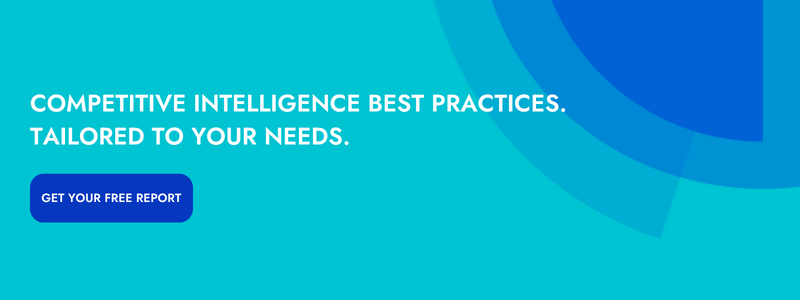While they might be a thorn in your side, your competitors aren’t special.
They, like every other business on the planet, are coming into 2023 with all kinds of newfangled ideas. The optimists are plotting means by which AI can be leveraged to incite hypergrowth and the pessimists are streamlining and building efficiencies to help weather a potential recession.
Regardless of how your competitive landscape maps across the glass half empty/full spectrum, you need to understand the moves they’re making and, ideally, their endgame. Unfortunately, keeping tabs on your competitors isn’t as easy as simply following them on Twitter (Mastodon?) and reading online reviews.
Effective competitive intelligence requires constant aggregation and analysis in order to turn information into actionable insights. But how do you get the right intelligence, how do you draw conclusions from that data, and what do you do with that analysis?
It ain't easy.
But there’s hope! Here are 8 steps to get you started with spotting and leveraging competitor trends.
First, though…
Why You Need to Care About Competitor Analysis Trends
You need to care about competitor analysis trends because they’re an essential path to staying competitive in your markets.
By developing an understanding of who’s doing what and why, you’re able to gain insight into competitor's offerings, marketing strategies, product reviews, prices, and more.
Understanding what your competitors are doing means you can optimize your own products and services, developing effective strategies to increase profits and stay ahead of the competition.
Alright, let’s get into it.
Spotting Competitor Analysis Trends in 8 Steps
Step #1: Monitor every single activity
When it comes to CI, less is not more.
It’s important to monitor your competitors to gain a competitive advantage, which means paying attention to:
- Go-to-market strategy
- Positioning
- Web presence
- Product
- Pricing
- Packaging
- News
- PR
- Events
- Team and personnel changes
- Reviews
- Support content
- Content
- Ads
- Social
- Customers
- Partners
… and that’s a non-exhaustive list.
Knowing how your competitors operate allows you to glean insight into what strategies and tactics are being deployed (and which are actually working!) in your industry — allowing you to avoid mistakes competitors make and replicate their successes, iterating and refining their processes for better results.
Step #2: Conduct zero-party research
In case you’re unfamiliar with the term, Forester defines zero-party data as:
"Data… which a customer intentionally and proactively shares with a brand. It can include preference center data, purchase intentions, personal context, and how the individual wants the brand to recognize [them]."
Aka — it’s survey time
Surveys can provide you with a detailed picture of your competitive landscape and can be used to shape your product marketing strategy. When you survey customers you gain insights into their experiences with your competitors — which will help you understand perceptions, preferences, and trends in the market.
Step #3: Build a quarterly benchmarking system
Monitoring your competition’s progress at specific moments in time allows you to identify any weaknesses they may have that could offer opportunities for you to advance over them.
This helps you gain insights into what’s working for your competitors (and what isn’t) and identify ways you can use those practices to your own benefit. It also gives you an understanding of their strategic direction, which can help you to anticipate their next steps in order to stay ahead of emerging trends.
Finally, understanding your competitors’ performance provides you with valuable feedback that can aid you in refining and pushing your own growth strategy forward.
Step #4: Drill deep on pricing
Understanding the current pricing climate and your competitors’ pricing structures is important for setting your own competitive prices for a number of reasons:
- It gives you a better idea of what customers expect to pay for similar products or services (so that you can adjust your prices accordingly)
- It allows you to better understand your competitors and learn the strategies they are employing to attract and retain customers (penetration pricing, prestige pricing, etc.)
- It enables you to set your own pricing, designed to give you the best chance of success without necessarily leaning on simply undercutting the prices of your competitors
Finally, pricing research will also help you to gain insight into considering competitive pricing models to give your customers the greatest possible value while still allowing you to profit.
Step #5: Monitor reviews
Monitoring your competitors’ product reviews on platforms like G2 and Trust Pilot can help you gain a better understanding of the quality of their products and identify areas for improvement in your own offerings.
This information can help you refine your products and services in order to stay competitive in the market and to better serve your customers. It can also be used to inform your acquisition strategy and target potential customers who may (currently!) prefer the services or products of your competitors.
When you continuously review sites, over time, you can:
- start to identify trends (“onboarding is terrible,” “the price is too high”)
- spot anomalies
- develop a better understanding of the types of customers who like (or dislike) aspects of your competitors’ products
Using a competitive intelligence platform that can directly intake, filter, and analyze competitor reviews makes this process much easier and allows for more in-depth analysis of trends and anomalies. If you’re ready to get started, book a demo today.
Step #6: Identify their ICPs
Understanding your competitors’ target customer (aka their buyer persona) can be incredibly beneficial to your business, while being one of the most effective ways to determine your direct and indirect competitors.
By studying what your direct competitors — the brands who sell a similar product to a similar audience — are doing, you can gain insights into what is working, what appeals to your target audiences, and how to create more effective, differentiated campaigns for your own products.
This enables you to identify opportunities to better target and reach your own desired audiences, differentiate your marketing messaging, and ultimately improve the return on investment for your marketing efforts by doing the most effective job of resonating with target customers.
Step #7: Analyze your own customer feedback
Analyzing customer feedback helps you identify areas that can be improved upon and capitalize on.
Specifically, you can use this feedback to understand which areas customers may perceive as advantages of your competitors products or services over yours. Additionally, understanding customer feedback can help you identify any weaknesses your competitors may have and develop strategies to address them.
This can help you stay ahead of the competition and give you an advantage when it comes to offering a better customer experience.
Step #8: Track competitive win rate
If you’re unfamiliar, competitive win rate is calculated as the ratio of deals won over opportunities in which a given competitor was involved.
Tracking your competitive win rate is essential for identifying upstart competitors who might be infringing on your market share.
It can also help you identify the competitors your sales reps traditionally struggle to close against and the assets that are helping them succeed (or those that could use a refresh). This kind of analysis can also help inform your own marketing strategy and give you ideas for how to position yourself in the market.
Using Competitive Intelligence to Spot Competitor Analysis Trends
Gathering and analyzing competitive intelligence is a full-time gig.
Crayon can help.
Our competitive intelligence solution helps businesses (like yours!) capture, analyze, and act on what’s happening within their markets.
So that big ‘ol list of trends to watch…
- Monitor your competitor’s online presence, marketing tactics, and promotions to track their every move.
- Utilize surveys and studies to collect first-hand data about your competition.
- Analyze your competition’s performance and gauge their progress. Then refine your own strategies from there.
- Understand the current market pricing climate and your competitors’ pricing structures in order to set your own competitive prices.
- Monitor your competitors’ reviews and ratings to determine the quality of their service or product.
- Determine who your competitors are targeting and how their marketing messages are resonating with them.
- Analyze customer feedback of your competitors to identify their strengths and weaknesses.
- Track your competitors’ market share performance over time to see how they compare.
… Crayon helps make it manageable.
What are you waiting for? Learn how Crayon can help you own your competitive landscape in 2023 today.
.jpg)
Related Blog Posts
Popular Posts
-
 How to Create a Competitive Matrix (Step-by-Step Guide With Examples + Free Templates)
How to Create a Competitive Matrix (Step-by-Step Guide With Examples + Free Templates)
-
 The 8 Free Market Research Tools and Resources You Need to Know
The 8 Free Market Research Tools and Resources You Need to Know
-
 Sales Battlecards 101: How to Help Your Sellers Leave the Competition In the Dust
Sales Battlecards 101: How to Help Your Sellers Leave the Competition In the Dust
-
 6 Competitive Advantage Examples From the Real World
6 Competitive Advantage Examples From the Real World
-
 How to Measure Product Launch Success: 12 KPIs You Should Be Tracking
How to Measure Product Launch Success: 12 KPIs You Should Be Tracking





